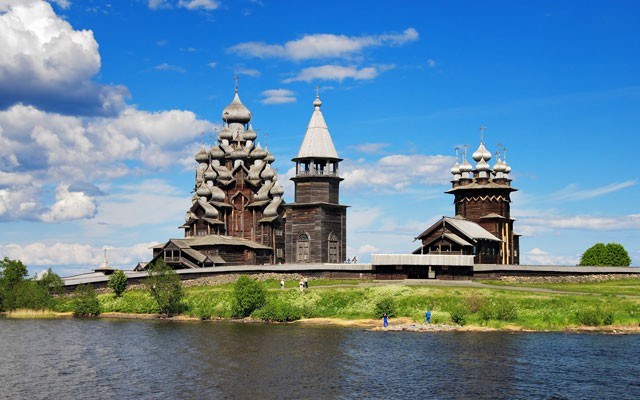Designated a UNESCO World Heritage site in 1990, Kizhi Pogost is located on a narrow southern spit on Kizhi island, part of the Kizhi Archipelago. The area is extremely remote, harboured in northwest Russia's Lake Onega, the second largest lake in Europe. The closest neighbouring country is Finland.
During the winter, this isolated area can experience extremely cruel weather, with temperatures dropping to 35 and 40 degrees below zero. But come summer, however brief it may be, the weather is idyllic and transforms the region into a haven for nature, and tourists wanting to visit the legendary wooden churches and fairytale landscapes of Russia.
I came to Kizhi Pogost via a Viking River Cruise from St. Petersburg to Moscow. It was only after our morning visit that I would learn how difficult this place is to get to.
We are greeted by our English guide, Pavel Tolmachev — a handsome young Russian in his late 20s, who works as an English teacher in the winter and an English guide at Kizhi during the summer. (He shared with me that during his spare time, he was studying to become a lawyer in international business law, whereupon he pulled out a three-inch text book to show me his studies.) He proceeds to take us on a narrated stroll of the pogost.
What exactly is a pogost?
Most westerners are not familiar with the term pogost, which is simply a Russian term designating a small settlement with a church and a graveyard. The Kizhi Pogost includes a winter church, a summer church, and an octagonal belfry constructed during the 18th century. All are built of wood with no hammer or nails, a typical Russian architectural feature and carpentry tradition of the time.
Standing approximately 37-metres tall, the 22-domed Transfiguration Church is considered the jewel of the compound. Built in 1714, it is one of the tallest log structures in the world. Because of its spaciousness, it was used only as a "summer church" since heating wasn't a factor. Legend has it that the main builder only used one axe for the entire construction, and that upon finishing the church, he threw the axe into the lake saying, "there was not and will be not another one to match it." The nearby "winter church" is simpler in structure, with only nine onion domes. It is known as the Church of the Intercession.
Along with the two churches and bell tower, there are several other smaller churches, homes, windmills, gardens, domestic artifacts and tools. Tolmachev sums it up best when he says:
"Kizhi,..? It is one of the most beautiful places in the world. A small island in the north of Russia maintaining traditions of Russian wooden architecture. As soon as a newcomer visits the island they learn about ancient log churches built without nails, charming village chapels with wonderful bell ringing, big farmer's houses where people and cattle lived under the same roof, as well as traditions of making headdresses and ornaments, Kizhanka wooden boats, sewing, and folk storytelling. Thus this place is called the treasure of Russian people's culture living in the north. But Kizhi is also a marvellous place for making friends, as people from all over the world seek to visit this place. So it is in a day's time one may hear a great number of languages while walking on the island."
The miracle of Kizhi Pogost
However, the most poignant story about Kizhi is the story of a Finnish pilot during the Second World War. Once again, our guide and storyteller Tolmachev narrates the heart-stopping events:
"I learned the story of the Finnish pilot from a teacher while attending preparatory courses for tour guides in the Kizhi museum in 2006. "During World War II a Finnish pilot, named Laus Del Saksel, was ordered to find and destroy a commando unit that was possibly hiding in the churches on the island of Kizhi. When his plane was flying over the ensemble he saw many onion-shaped cupolas and was amazed with beauty of the Kizhi churches! He told his fellow mate not to drop a bomb on the churches. So they kept on flying and dropped the bomb in lake Onega instead.
"As Laus Del Saksel's wife recollects, his personal diary was lost in fire. This story may have passed into a beautiful legend but the key idea, in my opinion, is that even if there is a world war people can do everything in their power to protect priceless monuments!"
How to get there
Kizhi Pogost is in the middle of nowhere and is challenging to get to. During the summer, visitors can reach Kizhi by an organized shipboard excursion from St. Petersburg. Viking River Cruises stops here on the "Waterways of the Tsars" itinerary. This is perhaps the easiest way to visit.
From June through August, you can also catch a 75-minute hydrofoil three times daily from the Petrozavodsk ferry terminal. (Petrozavodsk is the capital of the Republic of Karelia, about 67 kilometres south of Kizhi.) During the winter you might as well forget about getting there unless you have access to a dogsled or maybe a helicopter.
Admission to Kizhi is separate from the hydrofoil and is currently 880 rubles, or about $13 USD.




